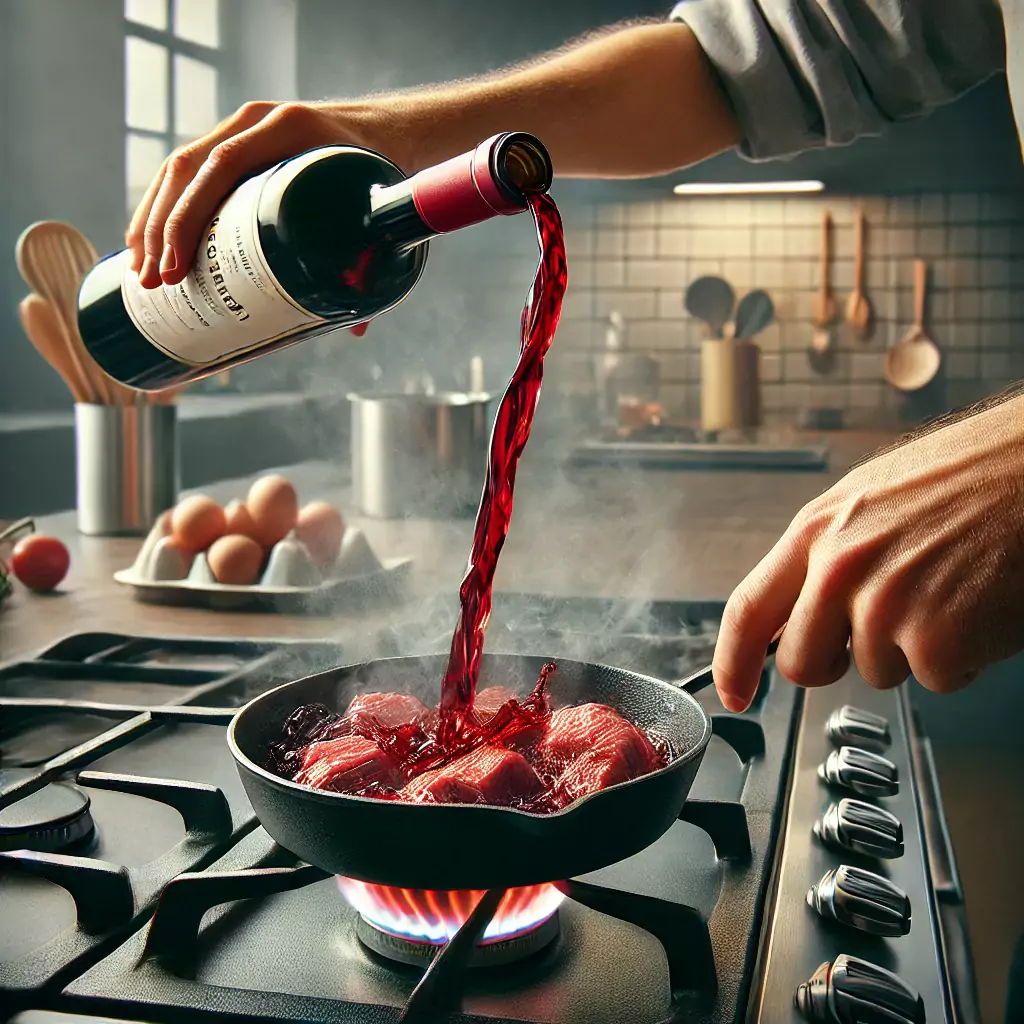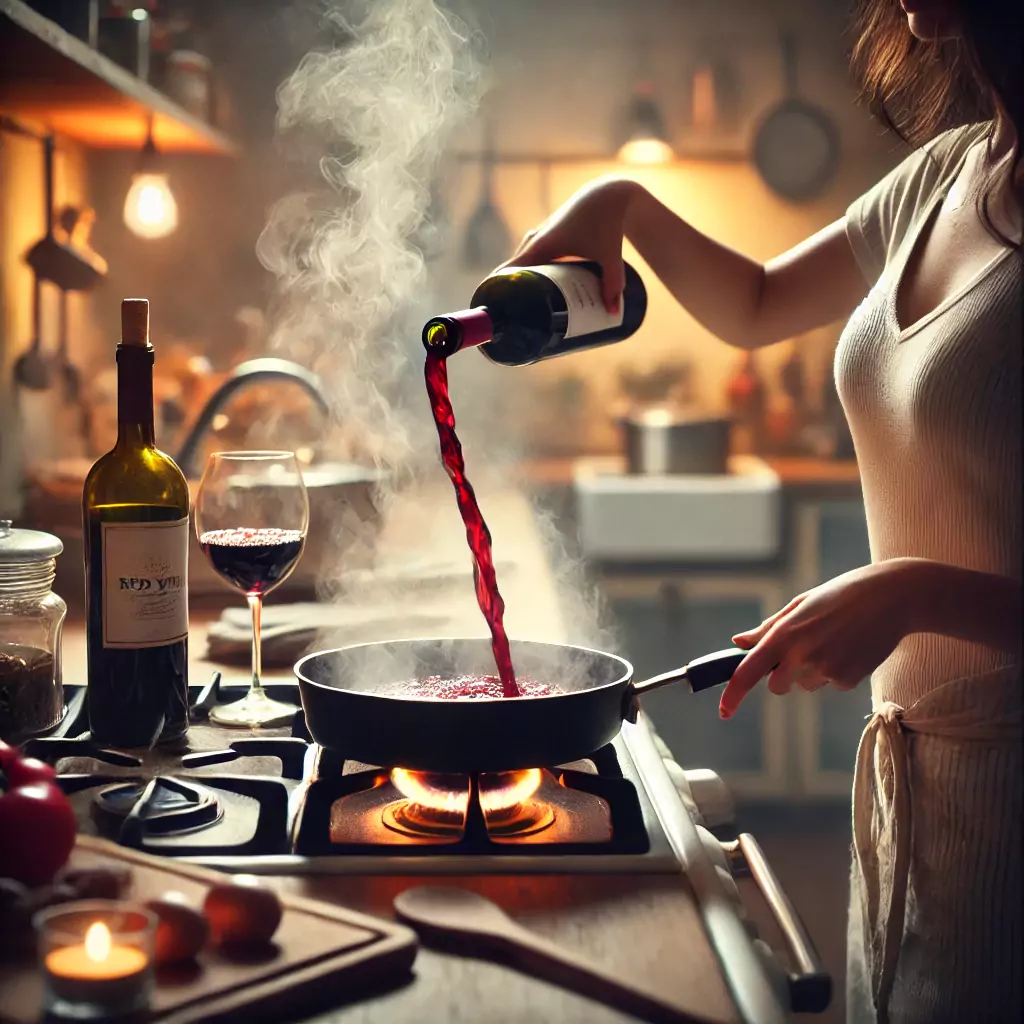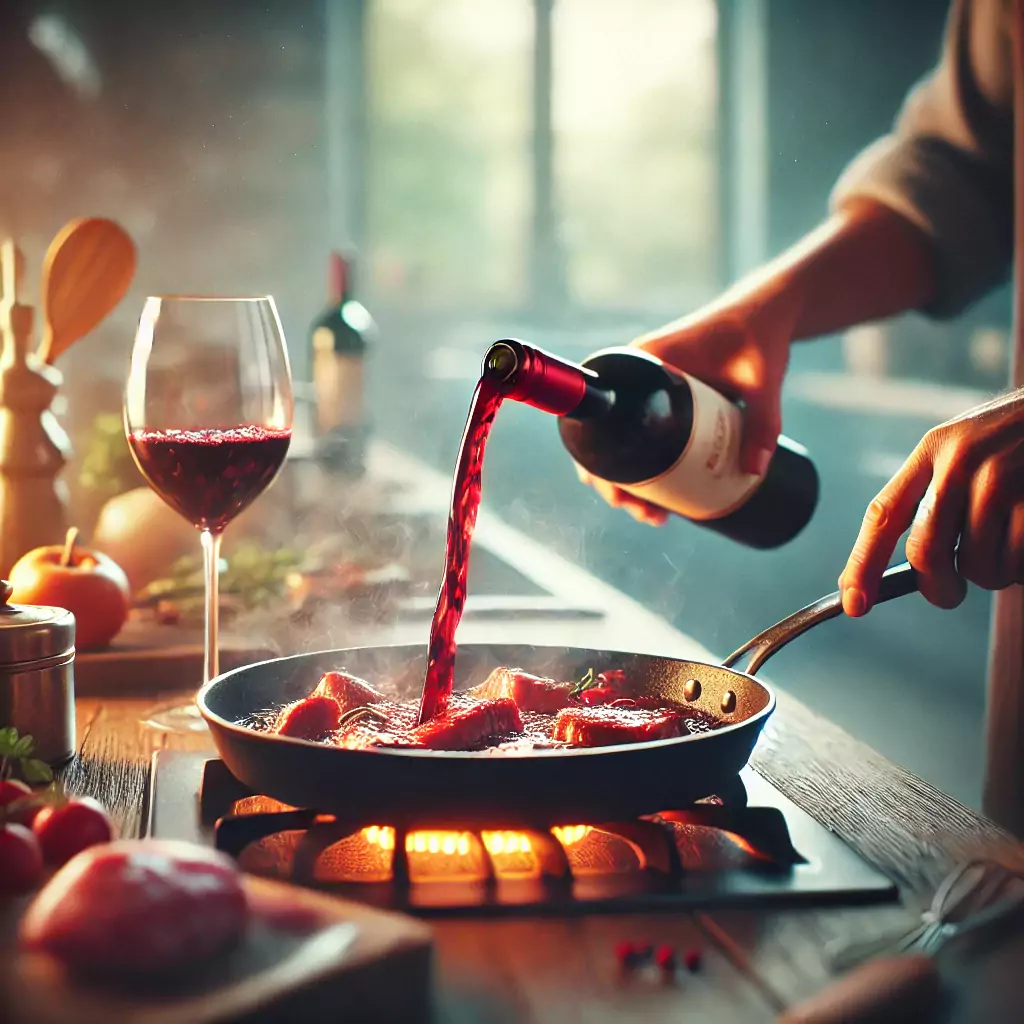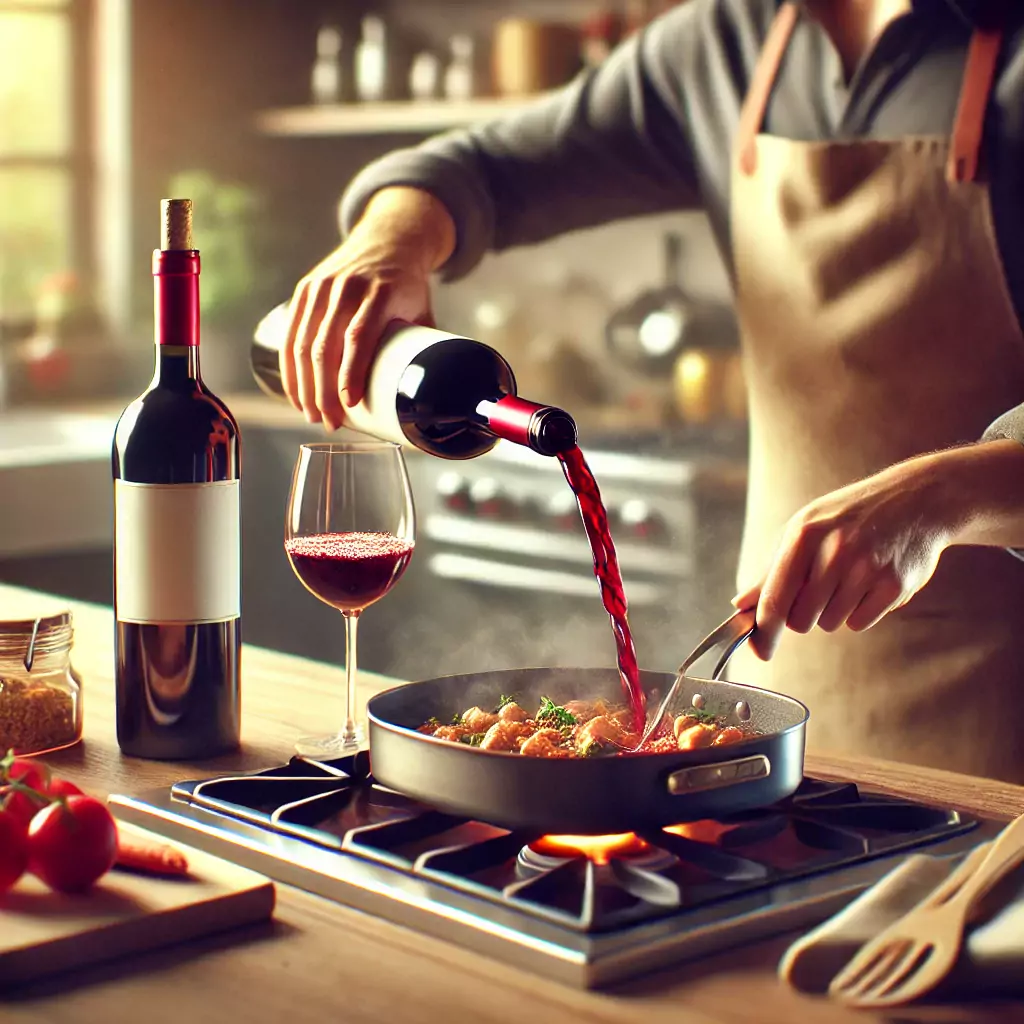Red Wine for Cooking
How to Choose It and Make the Most of It in Your Recipes
What Type of Red Wine is Best for Cooking?
Using red wine for cooking can transform a dish, adding depth, complexity, and an extra layer of flavor that elevates any recipe. However, not all wines are created equal, and not just any bottle you have at home is suitable for cooking. Knowing how to choose the right red wine for cooking is crucial to achieving the best results in your dishes. Here, we explain what aspects to consider when selecting a good red wine for cooking and which options are the best.
The Balance Between Quality and Price
One of the most common mistakes when choosing red wine for cooking is thinking that any cheap wine will do. While you don’t need to spend a fortune on an exclusive bottle, it’s also not recommended to use very low-quality wines or those that have been open for too long. A poor-quality wine will translate into unpleasant flavors in your recipe, as the wine’s flaws tend to intensify during the cooking process.
Ideally, you should opt for a mid-priced wine that is pleasant to drink on its own. As a general rule, if the wine isn’t enjoyable in the glass, it won’t improve in the pan. Choose a red wine for cooking that you like, but one that also fits within a reasonable budget.

Dry Red Wines: The Most Versatile for Cooking
Dry red wines are one of the most versatile options when it comes to cooking. Varieties like Cabernet Sauvignon, Merlot, and Syrah are excellent choices for cooking. These wines provide balanced tannins, fruity and spicy notes that enrich sauces, stews, and reductions without adding excessive sweetness.
Cabernet Sauvignon is perfect for hearty dishes like stews and red meats. Its body and dark fruit and spice notes add deep flavor that complements rich, fatty ingredients. Merlot, on the other hand, has softer tannins and a more approachable fruity profile, making it an excellent option for lighter sauces or dishes with poultry and pork. Syrah, with its spicy and earthy touch, is ideal for stews or dishes that require a bolder flavor.
Wines with Low Acidity and Fewer Tannins
While wines with pronounced tannins can work in specific dishes, for everyday cooking, it’s preferable to use a red wine with softer tannins and low acidity. A wine that is too acidic or tannic can make a dish bitter, especially if the recipe calls for reducing the wine during cooking.
Pinot Noir and Garnacha are excellent options if you prefer a red wine with lower acidity and softer tannins. Pinot Noir is ideal for delicate dishes like chicken or fish stews, while Garnacha offers soft fruity notes, perfect for recipes that don’t require overly intense flavors.
Avoid Overly Sweet Wines
Another aspect to consider when choosing a red wine for cooking is avoiding overly sweet wines unless the recipe specifically calls for them, such as in desserts or reductions for meat dishes with fruit. Sweet wines, like dessert wines or fortified wines, can make the dish overly rich or unbalanced.
Unless the recipe explicitly states that a sweet wine should be used, opt for dry or semi-dry wines. These wines better balance the flavors and allow the main ingredients of the dish to shine without overpowering them with excess sweetness.
Benefits of Using Red Wine for Cooking in Your Dishes
Red wine for cooking is an ingredient that not only adds a touch of sophistication to your dishes but also enhances the flavor, texture, and aromas of your recipes. Whether you’re preparing a stew, a sauce, or a braise, red wine can transform a simple dish into a more complex and rich culinary experience. Below, we explore the main benefits of using red wine for cooking and how it can elevate your meals.
Adds Depth of Flavor
One of the greatest benefits of using red wine for cooking is that it brings a rich depth of flavor to dishes. During cooking, the alcohol in the wine evaporates, but the aromatic compounds, along with fruity and spicy flavors, remain. These flavors integrate with the other ingredients in the recipe, creating a more complex and nuanced profile.
In sauces and stews, red wine adds notes of dark fruits, spices, and earthy touches that enrich the base flavors of the ingredients. For example, adding red wine to a beef stew helps to tenderize the meat juices and enhance the flavors of the vegetables, creating a harmony of flavors that’s hard to achieve without this ingredient.
Improves Meat Texture
Red wine for cooking also acts as an excellent meat tenderizer. The tannins in red wine and its acidity help break down the fibers in meat, resulting in a more tender and juicy texture. This is particularly useful in recipes that require long cooking times, such as braises or roasts.
When marinating meat in red wine for cooking, the tenderizing process is accelerated, and the flavors of the wine infuse into the meat, enhancing the taste of every bite. This technique is particularly effective with tougher cuts of meat, such as pork loin or lamb, which need a little extra help to become tender and flavorful during cooking.

Enhances the Aromas and Flavors of Other Ingredients
Red wine for cooking not only adds its own flavors to a dish but also helps highlight the aromas and flavors of the main ingredients. In sauces and stews, red wine acts as a flavor enhancer, balancing acidity, softening strong flavors, and making the ingredients work together harmoniously.
For example, in a tomato sauce for pasta, red wine adds a tangy and spicy touch that balances the natural sweetness of the tomatoes and boosts the flavors of herbs and spices. Similarly, in a meat stew, red wine intensifies the earthy flavors of carrots, mushrooms, and onions, creating a more complete and robust dish.
Adds Sophistication to Dishes
Another benefit of using red wine for cooking is that it adds a touch of sophistication to even the simplest recipes. Including wine in a recipe not only enhances its flavor but also gives it a sense of elegance and refinement. This is especially useful when preparing dishes for special occasions or formal dinners.
Using red wine in dishes like coq au vin, risottos, or stews elevates the meal, making it seem more elaborate without the need for complicated techniques. Additionally, red wine is perfect for creating reductions and sauces that add a refined finishing touch to any dish.
Enhance Your Dishes with Holland House Marsala Cooking Wine
🍽️ Perfect for Cooking: Elevate your cooking with the rich, deep flavor of Holland House Marsala Cooking Wine. Ideal for sauces, gravies, and savory dishes, it adds complexity and depth to your favorite recipes.
🍴 Versatile & Delicious: Whether you’re preparing a classic chicken marsala or experimenting with new dishes, this cooking wine is the perfect ingredient to enrich the taste of your meals.
🌿 Made with Quality Ingredients: Crafted with the finest marsala wine, this cooking wine brings authentic flavor to your kitchen. No preservatives, just the pure taste you need.
🎁 A Must-Have for Home Chefs: This cooking wine is a kitchen essential for anyone who enjoys making flavorful, restaurant-quality meals at home.
Classic Recipes That Shine with Red Wine for Cooking
Red wine for cooking has been an essential ingredient in many kitchens around the world, especially in European cuisine, where it is used to enhance sauces, stews, and meats. Over time, classic recipes have been created that rely on red wine to achieve a perfect balance of flavors. These recipes are not only cherished for their taste but also for how red wine transforms everyday dishes into richer, more sophisticated culinary experiences. Below, we explore some of the most iconic recipes that shine thanks to red wine for cooking.
Beef Stew with Red Wine (Beef Bourguignon)
One of the most classic and well-known recipes that uses red wine for cooking is Beef Bourguignon, a hallmark of French cuisine. This stew requires slow cooking chunks of beef, mushrooms, carrots, onions, and aromatic herbs. The star of this recipe is the red wine, which is combined with beef stock to create a rich, flavorful sauce.
Red wine for cooking in this recipe, typically a Pinot Noir or a dry red wine, helps tenderize the meat and adds a complex depth that is hard to match with other ingredients. As the wine reduces during cooking, it intensifies the flavors of the dish, resulting in a tender, juicy stew. Served with mashed potatoes or a crispy baguette, Beef Bourguignon is a perfect choice for a comforting and elegant meal.

Coq au Vin
Coq au Vin is another classic French recipe that relies on red wine for cooking to develop its signature flavor. Traditionally made with rooster or chicken, this dish is slowly cooked in a mixture of red wine, mushrooms, carrots, onions, and garlic. Red wine is essential in this recipe, as it is used both to marinate the meat and for the cooking process, allowing the wine’s flavors to fully integrate into the dish.
The red wine not only adds flavor but also acts as a tenderizer, leaving the meat tender and juicy. The result is an aromatic, flavorful stew that is best enjoyed with rice or steamed potatoes, which absorb the dish’s juices beautifully.
Red Wine Risotto
Red wine risotto is a variation of the classic Italian risotto that uses red wine for cooking instead of the traditional white wine. This dish stands out for its beautiful purple color and deep flavor, making it a sophisticated option for special occasions. Like other risottos, it is cooked slowly, adding broth gradually to achieve the characteristic creamy texture, but in this case, a generous amount of red wine is added to the rice first.
Red wine for cooking gives the risotto a more robust and earthy flavor compared to white wine, complementing ingredients like mushrooms, Parmesan cheese, and fresh herbs. This dish is an excellent choice for those looking for a more intense version of a classic risotto.
Red Wine Sauce for Meat
While not a dish on its own, red wine sauce for cooking is one of the most versatile and delicious preparations you can make to accompany red meats such as steaks or lamb chops. This sauce is prepared by reducing red wine, typically a Cabernet Sauvignon or Merlot, with shallots, garlic, butter, and beef stock. As the wine reduces, it concentrates in flavor, resulting in a rich sauce with notes of dark fruits and spices.
Serving a steak with a red wine sauce elevates the dining experience, adding complexity without overpowering the natural flavors of the meat. This sauce is perfect for special dinners and can be prepared in advance to save time.
Common Mistakes When Using Red Wine for Cooking and How to Avoid Them
Red wine for cooking is a versatile ingredient that can transform a dish, adding depth and richness of flavor. However, there are common mistakes when using it in the kitchen that can negatively affect the final result of recipes. From choosing the wrong wine to not understanding how to incorporate it properly into dishes, these mistakes can easily be avoided with a few simple tips. Below, we highlight the most common mistakes when using red wine for cooking and how to correct them to get the most out of this delicious ingredient.
Mistake 1: Using Low-Quality Wine
One of the most common mistakes is thinking that any red wine, even low-quality ones or bottles that have been open for too long, are suitable for cooking. A poor-quality red wine or one that has been oxidized for days can have undesirable flavors, such as bitterness or excessive acidity, which will transfer to your dish.
How to avoid it: While you don’t need to use an expensive bottle, it is always advisable to use a red wine for cooking that is good enough to drink. Choose a mid-priced wine that you enjoy, as if the wine is pleasant to drink, it will also be good for cooking. Avoid wines that are past their prime or have been open for more than 3 or 4 days.
Mistake 2: Not Reducing the Wine Properly
Another common mistake is adding red wine to the dish and not allowing enough time for it to reduce and concentrate. When red wine is added to a sauce or stew, its alcohol and acidity need to be reduced through cooking so that the flavors integrate properly. If it’s not reduced enough, the wine can add a harsh acidic and alcoholic note to the dish instead of enriching it with its fruity and spicy flavors.
How to avoid it: After adding red wine for cooking, be sure to cook it over medium or low heat for a few minutes to allow it to reduce. The reduction will allow the alcohol to evaporate, and the flavors will concentrate. It’s important not to rush this process, as patience is key to achieving a rich, balanced sauce.
Mistake 3: Using Sweet Red Wine in Savory Recipes
Some cooks make the mistake of using a sweet red wine, like port or dessert wine, in recipes that are primarily savory. This can result in a flavor imbalance, making the dish too sweet and masking the main flavors of the recipe.
How to avoid it: Always choose a dry or semi-dry red wine for cooking when preparing savory recipes like stews, sauces, or braises. Sweet red wines are better reserved for desserts or dishes where sweetness is desired, such as fruit sauces or reductions to accompany meats with a sweet touch.

Mistake 4: Adding Wine Too Late
Another common mistake is adding red wine for cooking at the end of the dish’s preparation, when there’s no time for the flavors to properly blend. If the wine is added too late, it won’t have enough time to cook off and could result in a strong, unintegrated flavor.
How to avoid it: Add the red wine at the beginning of the cooking process or at least with enough time for it to reduce and merge with the other ingredients. In a stew or braise, for example, the wine should be added along with the stock so that it has time to tenderize the meat and enrich the sauce.
Mistake 5: Using Too Much Wine
While red wine for cooking can add depth of flavor, using an excessive amount can be counterproductive. Too much wine in the recipe can result in a sauce that is too heavy or acidic, especially if it’s not properly reduced.
How to avoid it: Use red wine in moderation. Typically, half to one cup of wine is enough for most recipes that require a cooking liquid. If you feel the sauce needs more flavor, it’s better to add it gradually and taste until the balance is right.
Red wine for cooking can transform your dishes if used properly, avoiding common mistakes that can affect its flavor. With the tips in this blog, you’ll be ready to make the most of this ingredient in your kitchen. We invite you to keep exploring our website, where you’ll find more articles and recipes to help improve your culinary skills. Don’t miss our blogs, full of ideas and tips to make every meal a delicious and memorable experience. Keep discovering new ways to enjoy wine and cooking!
